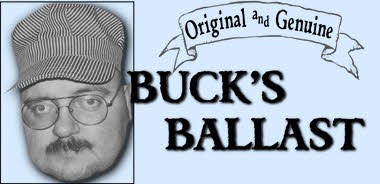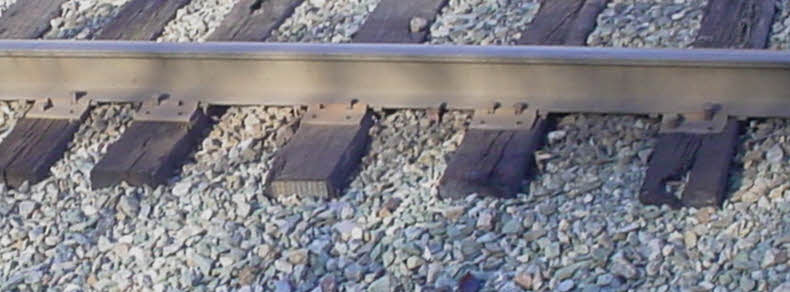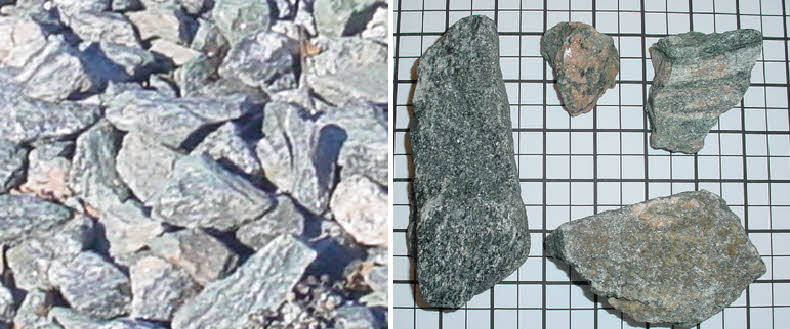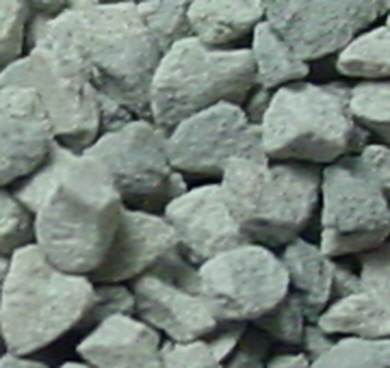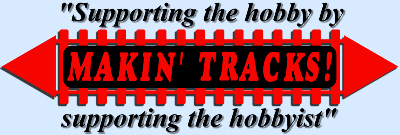
3418 Meadow Wood Lane, Crozet VA 22932 |
|
|
Ballast THIS! Makin' Tracks, in conjunction with Bucks Trains Unlimited, is pleased to offer "Buck's Ballast, a track ballast made from real stone, which we think hits the sweet spot at the junction of realistic appearance, economy, and ease of application. Appearance: REAL ballast may look very different from what we have in our mind's eye. So, that's where we started, with a visit to the CSX main line a few miles away: |
|
|
|
|
|
At this range, the color variation (dozens of colors, actually) and the irregular sizes and shapes come into view. Let's look more closely: |
|
|
|
|
|
Above, left, our close up taken from the picture above shows the variations are
much greater then we might have imagined. We took samples which you see on a
grid above right (bold lines are 1 inch). THAT is how real world ballast really
looks.
By contrast, at immediate right is a magnified view of a popular product made from tree nut by-products. There is some variation of size. However, the individual "stones" are plainly not as irregular as actual ballast, and they are also a bit too big. If expanded to real world size, they'd be about the size of bowling balls or small pumpkins. And as is obvious, this kind of manufactured ballast has almost no color variation. The uniform appearance makes the nut shell product look good, but that's the problem - it is TOO "good" to be true. Some people will mix various shades together, such as dark and medium grey. And that just produces a salt and pepper appearance. |
|
| Buck's Ballast solves the problem by letting Mother Nature do most of the work. We just take it a step further, by gathering up the quarry siftings, crushing them, and screening to HO size. The picture below was sent by "JR," who is one of our test panel members. He said he was quite pleased with the result - and we think you can see why. | |
|
|
|
| Now, of course, real ballast varies in color from one region of the country to another. So some modelers may want to add a wash to lighten or darken Buck's, or push the general color tone one way or another. This can be done by coloring your glue mix, or dry brushing or applying a wash to the installed product. Meanwhile, we'll be working to introdice color variants of our own. | |
|
Mechanical and Physical Properties: Good looks are one thing - performance and ease of application is another. We claim that Buck's Ballast takes the blue ribbon here, as well. Weight: Light weight nutshell ballast is susceptible to static charge. The ballast will often jump - and we mean, physically fly through the air - from roadbed to the rails or tops or ends of the ties. The more you try to drag it away, the more static you create! Maddening. But Buck's Ballast is massive, weighty stuff, and stays put. Magnetic Attraction: Modelers will recognize a possible hazard with a real mineral based product like Buck's. Stray particles with a metallic content may be drawn toward the magnets of your locomotive motors. This, in fact, is a complaint about a competing, mineral based product. Like a track nail, staple, or any similar small metal object, there is the possibility of creating a short circuit if the object is drawn into an open frame motor or other parts of the mechanism. And this is why Buck's takes the extra step of passing the ballast through a magnetic field in excess of 200 pounds of pulling force. Buck's is both physically washed and magnetically cleaned. Ease and Speed of Application: The weight alone of Buck's Ballast makes it resistant to flooding away when glue and water mixtures are applied to it. The irregular shape of the stones has an inter-locking property that makes them resist rolling. Buck's is more stable on the slope of your roadbed. One of our test panel reported, ". . . I think this un-evenness helps the ballast hold its shape when applied . . .". With enough force, of course, you could blast away the ballast with a heavy squirt of glue mixture, the same as chasing gravel with a garden hose. But in actual practice, you can be more aggressive in applying the glue. There is no need, really, to apply a bead of glue along the bottom edge of the slope and allow it to "wick into" the particles above by osmosis. Thus, your work goes more quickly. In fact, Buck's can be applied in in just one pass - between the rails and along the slopes on both sides. No need to do the middle and then the sides as separate operations. Apply dry ballast, wet it, then glue it. See link to the very simple 3 step instruction sheet, below. Some of our test panel of product evaluators noted that Buck's Ballast seems to have some powder or dust in the mix. It DOES. Although the product originates with washed stone from the quarry, we wash it again to remove residual dirt and clay. Even so, there is still some powder which is visually present in the product you receive. At first, we were concerned. But, we soon observed that the powder actually combines with the glue to produce a very solid bond among the larger stones, resulting in a secure finished job. It washes into and among the stones, disappearing from view in the finished work. Your project therefore looks good and is literally rock-solid. Perfect! Finally, as veterans of the hobby will know, it is nearly impossible to shape the profile of the light weight product while it is still wet. The product will simply stick to you, or whatever shaping tool you use. However, you CAN "get away with" some manipulation of Buck's Ballast. A popsicle stick or similar tool (metal is preferable) may be used to conform Buck's Ballast to the profile of the roadbed after application of glue, and before the glue has dried. Some stone will stick to your tool - but not very much. So feel free to gently tamp, scrape and shape. Economy of Application: Products from vegatable matter and similar light weight products require a certain layer thickness to give a desired profile when dry, so make them less "touchy" while being applied. But the weight of Buck's Ballast means you can use a thinner layer to cover the road bed. And, pound for pound, Buck's is much less expensive to use and to buy than alternative products. New Ballasting Methods: Everyone has developed their own favorite way to apply ballast, and no doubt will do the same with Buck's. However, owing to the advantages discussed above, we have prepared a set of application instructions which fully exploit Buck's unique properties, for speedy and convenient application. Click this link for 3 Easy Steps to Ballast Application. Test Results: Buck's Ballast has been fully tested by a panel of modelers, as well as a few early customers. We have selected representative reports, including what some regarded as detractions, together with our response to problems or issues raised. Click this Test Panel Reports link to see the document. Pricing: One unit of Buck's Ballast weighs about 2 pounds (enough for 30-50' of track, depending on application). Product is delivered in a heat sealed, heavy duty, 8 mil thick poly bag. Shipping is included in the price. 1-4 units: 12.00 ea. Shipping is included in the price.
|
|
|
Orders Click here to place order for Buck's Ballast. Clubs and dealers, please contact us at jsgeare@yahoo.com, or by phone: 434-823-4809. |
|
|
Arthur Elks, Jr. (Buck is his nick name) is nothing if not the definition of a working man. He's skilled in many areas, but his basic day job is hauling loads of gravel, dirt, fill or asphalt to wherever it's needed. And he's something else, too! He is an HO rail modeler, and so has a natural interest in anything connected with the hobby. One day, he responded to a question about ballast posed on a Yahoo Group discussion board. And he noted that he had no problem finding it at the quarry. He scraped up the left over siftings, washed them and then screened them to make his own ballast. And that got MY full attention, so I contacted him to ask if he would send me a sample, which he immediately did. And I, in turn, experimentally applied it to a run of track. That SETTLED IT! "This is the right stuff," I thought. So then I asked Buck if he might be able to make it in production quantities. "I'll let you know," he said. He then put on his mechanic's hat and welder's mask, and produced a screening table. He called me back in a day or so to report he could do the job. And that's how it all started. Since then, his original equipment has been upgraded with screening vibrators and he's added a rock crushing machine. Although WE knew the stuff was good, we needed someone ELSE to agree. The agreement wasn't long in coming, from a few miscellaneous modelers, then from our test panel, and finally from the product's introduction at the Greensboro train show, where every last bag (except for 2 sample bags) sold out hours before the show closed. Subsequently, we have sold out of the product in other shows, and are nowe shipping to dealers who recognize the superior appearance and performance benefits. So, there you have it, the origin of Buck's Ballast - the "Original and Genuine." |
|
